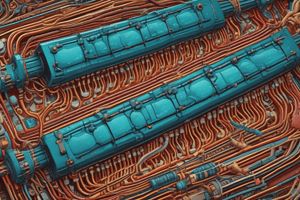Podcast
Questions and Answers
What is the main advantage of using parallel circuits?
What is the main advantage of using parallel circuits?
- They allow currents with different amplitudes to flow concurrently
- They provide redundancy by offering multiple paths for current flow (correct)
- They guarantee that all components function interdependently
- They reduce overall energy loss due to heat dissipation
In a parallel resistor network, how is the total resistance calculated?
In a parallel resistor network, how is the total resistance calculated?
- $R_T = R1 + R2$
- $R_T = \frac{1}{\frac{1}{R1} + \frac{1}{R2}}$ (correct)
- $R_T = R1 - R2$
- $R_T = R1 \times R2$
Why does using parallel circuits lead to more even power distribution among components?
Why does using parallel circuits lead to more even power distribution among components?
- Because all components in parallel circuits have the same resistance value
- Because parallel circuits reduce the total current flow through each component
- Because parallel circuits increase the overall resistance of the circuit
- Because each branch in a parallel circuit is independent, allowing components to function without affecting one another (correct)
What happens to the brightness of lights connected in parallel if one of them burns out?
What happens to the brightness of lights connected in parallel if one of them burns out?
Why is it important to convert all resistance values to a common unit in parallel resistor networks?
Why is it important to convert all resistance values to a common unit in parallel resistor networks?
What purpose does providing redundancy serve in parallel circuits?
What purpose does providing redundancy serve in parallel circuits?
Flashcards are hidden until you start studying
Study Notes
Parallel Circuits
Parallel circuits are electrical networks where components are connected across different branches of the circuit, allowing currents with different amplitudes to flow concurrently. This means that each branch of the circuit is independent from the others, and they can function without affecting one another. In other words, if you have two lights connected in series, when one burns out, both will go out. But if they're in parallel, only the burned out light goes out.
This configuration is commonly used in various applications such as lighting systems, audio equipment, and power distribution. One significant advantage of using parallel circuits is their ability to distribute power more evenly among components, which reduces overall energy loss due to heat dissipation. It also allows redundancy by providing multiple paths for current flow, ensuring that if one component fails, there are still other paths available for electricity to travel through.
Parallel Resistor Calculation
In a parallel resistors network, the total resistance is given by the formula R_T = 1 / (1/R1 + 1/R2 + ...). Here's how this works:
- Convert all values to a common unit. For example, if some resistances are measured in ohms and others in kilohms, convert them all to either ohms or kilohms.
- Divide each individual resistance value by its respective current flowing through it. To find the equivalent resistance, divide the resistance of the first resistor by the primary current, then add those results together and repeat until you've accounted for all resistors.
Let's take an example of three resistors in parallel, R1 = 6 Ω, R2 = 8 Ω, and R3 = 12 Ω, with a voltage source V = 100 V:
First, we need to calculate the combined resistance:
- R1: 6 Ω
- R2: 8 Ω
- R3: 12 Ω
Combined resistance: R_T = 1/(1/6 + 1/8 + 1/12) = 7.2 Ω
Now we can calculate the current flowing through each resistor using Ohm's Law: I = V/R:
I1 = V / R1 = 100 / 6 = 16.6 A I2 = V / R2 = 100 / 8 = 12.5 A I3 = V / R3 = 100 / 12 = 8.3 A
The total current I_Total flows through the system:
I_Total = I1 + I2 + I3 = 16.6 + 12.5 + 8.3 = 41.4 A
Studying That Suits You
Use AI to generate personalized quizzes and flashcards to suit your learning preferences.




